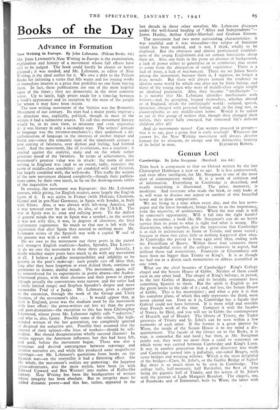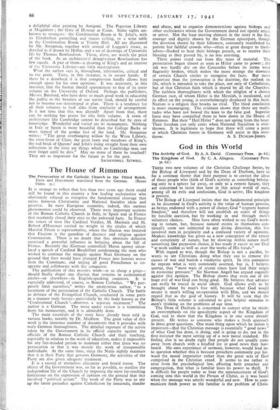Genius Loci
Cambridge. By John Steegman (Batsford. Jos. 6d.) THIS book is companion to that on Oxford written by the late Christopher Hobhouse a year or so ago. It is less controversial, and even nfore intelligent, for Mr. Steegman is one of the most alert of contemporary minds. It is a work of criticism and of information. Everything in Cambridge is described, and nearly everything is illustrated. The price, moreover, is moderate. And everyone who reads the book, or only looks at it, will want to discuss one aspect or another of this beautiful town and to draw comparisons.
We are living in a time when every day, and the last news- paper and the latest broadcast, brings home to us the importance, even the necessity, of architecture. When the war ends it will be someone's opportunity. Will it fall into the right hands? In the meantime, a book like Mr. Steegman's can do no better service than to point to what is right and what is wrong. His illustrations, taken together, give the impression that Cambridge is as rich in architecture as Siena or Toledo, and more varied ; because in those two cities little or nothing happened after 1600. At Cambridge the period is from 1450 until 185o, ending with the Fitzwilliam of Basevi. Within those four centuries there is the wonderful series of the colleges ; monastic in aspect, but without those sad associations. Fountains or Glastonbury can have been no bigger than Trinity or King's. It is as though we had ten or a dozen such monasteries or abbeys assembled in one town.
What are the chief beauties of Cambridge? King's College chapel and the Senate House of Gibbs. Neither of them could exist in any other land. The chapel of King's belongs, in period, to the late Gothic of Burgos, and its heraldic ornaments have something Spanish to them. But the spirit is English as are the green lawns to the side of it ; and, not less, the Senate House of Gibbs. This is his masterpiece ; and what a pity it is that his complete plans, of which this only represents the third, were never carried out. Even as it is, Cambridge has a façade that Gabriel could not have bettered. It is more solid and sensible than French work of the time. Compare it with the facades of Nancy, by Here, and you will see in Gibbs the contemporary of Hogarth and of Handel. The library of Trinity, the Tudor gateways of Trinity and St. John's can be seen within a few moments of each other. If the former is a great- interior by Wren, the inside of the Senate House is to my mind a dis- appointment. The façade of the library on to the Backs, it is true, is somewhat flat and hard ; but then, as Mr. Steegman points out, they were no more than a canal or waterway on which stone was carried between Cambridge and King's Lynn. It was in another generation that a great discovery was made and Cambridge turned into a palladian, one-sided Bruges, with stone bridges and weeping willows. Which is the most delightful of the bridges—Clare, St. John's, or the Gothic Bridge of Sighs? But there is so much more to be seen in Cambridge. The college halls, half-monastic, half Ratskeller, the best of them being the gigantic hall of Trinity, and the screen of St. John's with the portrait of Lady Margaret Beaufort. The chapels, too, of Pembroke and of Emmanuel, both by Wren, the latter with a delightful altar painting by Amigoni. The Pepysian Library at Magdalene ; the Gate of Honour at Caius. Some sights un- known to strangers: the Combination Room at St. John's, with its Elizabethan pannelling and stucco ceiling, or a wine table in the Combination Room at Trinity Hall. All are illustrated by Mr. Steegman, together with several of Loggan's views, as detailed as if drawn by Hollar, and a set of drawings of University life by Thomas Rowlandson. These, alone, are worth the price of the book. As an architectural draughtsman Rowlandson has few equals. A pair of them—a drawing of King's and an interior of the University Library—are little masterpieces.
What the author says is, throughout, informative, critical and to the point. Taste, in this instance, is in secure hands. If there be a drawback it is that compression hardly allows him enough space for his own opinions. It was necessary, in this instance, that the format should approximate to that of its sister volume on the University of Oxford. Perhaps the publishers, Messrs. Batsford, who have done so much good work in educating the public to the beauties of our native land, should be careful not to become too stereotyped in plan. There is a tendency for all their volumes to look alike from similarity of arrangement. Is it not time that this was altered? Apart from that, there can be nothing but praise for this little volume. A town of architecture like Cambridge cannot be described but by eyes of knowledge. Wonderful and varied are its monuments. Nothing in Italy or Spain is more beautiful than the College Backs or more typical of the genius loci of the land. Mr. Steegman writes: " The great overhanging willow by the Wren Library, the river-front of Clare, the great lawn and meadows of King's, the red brick of Queens' and John's rising straight from their own reflections in the river are things which no Cambridge man can ever forget until he dies." May no stone of them be touched! They are as important for the future as for the past.
SACHEVERELL SITWELL.































 Previous page
Previous page